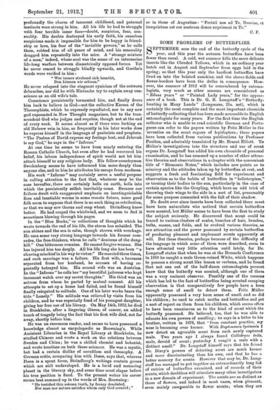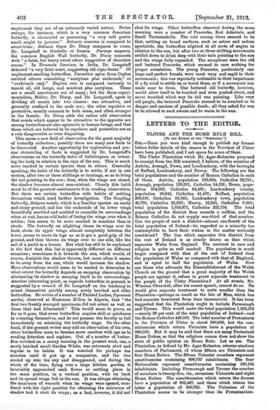SOME PROBLEMS OF BUTTERFLIES.
SEPTEMBER sees the end of the butterfly cycle of the year, and this year the autumn butterflies have been fewer than usuaL A cold, wet summer kills the more delicate insects like the Clouded Yellows, which in an ordinary year hatch out in August and September from eggs laid in the spring; so that this year only the hardiest butterflies have lived on into the belated sunshine, and the clover-fields and flower-borders have been the duller in consequence. How- ever, the summer of 1912 will be remembered by entomo- logists, very much as other seasons are remembered as "Edam years" or "Painted Lady years," for the appear- ance of a book. This is Dr. G. B. Longstaff's "Butterfly- hunting in Many Lands" (Longmans, 21s. net), which is certainly the most complete and the most important chronicle of butterfly-collecting that has been made accessible to English entomologists for many years. For the first time the English collector who is unable to read scientific German and Portu- guese can refer to the papers written by Fritz Miller in the 'seventies on the scent organs of lepidoptera ; these papers have been collected from various publications by Professor Poulton, and admirably translated by Mr. Ernest Elliott. To Miller's investigations into the structure and use of scent organs Dr. Longstaff has added his own chronicle of personal examination, and he has summed up a number of other attrac- tive theories and observations in a chapter with the convenient title of " Bionomic Notes," which includes new points as to mimicry and the attitudes taken up by butterflies at rest, and suggests a fresh and fascinating field for experiment and observation as to the habits of butterflies in "heliotropism," or turning their bodies to the sun, particularly in the case of certain species like the Grayling, which have an odd trick of throwing their wings to the side in a sort of list, presumably for some purpose connected with the fall of their shadow.
No doubt ever since insects have been collected there must have been naturalists who noticed that certain butterflies were scented, but Miller seems to have been the first to study the subject seriously. He discovered that scent could be traced to various clusters of scales, bunches of hair, brushes, tufts, manes, and folds, and he evolved various theories, as sex attraction and the power possessed by certain butterflies of producing pleasant and unpleasant scents apparently at will. But these theories, perhaps because of the difficulty of the language in which some of them were described, seem to have attracted very little attention until lately, for Dr. Longstaff states that when he was at the Brussels Conference in 1910 he caught a male Green-veined White, which happens to possess a strong scent like lemon or verbena, and he found that not one out of the half-dozen entomologists present knew that the butterfly was scented, although one of them was a very eminent observer. Possibly one of the reasons which has led to the fact of butterflies being scented escaping observation is that comparatively few people have a keen enough sense of smell to detect them. Fritz Miller apparently possessed a very keen sense of smell, and so did his children ; he used to catch moths and butterflies and get a sort of report on them from his children, which seems often to have been unanimous as to the kind of scent which the butterfly possessed. He believed, too, that he was able to educate his own powers of smelling ; he says in a letter to his brother, written in 1878, that "from constant practice, my nose is becoming ever keener. With Daplanoura lysimnia I now detect an agreeable scent from each newly captured male. Two years ago I always found Callidryas trite. male, devoid of scent ; yesterday I caught a male with a distinct smell." Dr. Longstaff himself says that his friend Dr. Dixey's powers of detecting scent are much keener and more discriminating than his own, and that he has a better memory for scents. However that may be, Dr. Long- staff has managed to put together an extraordinarily long list of entries of butterflies examined, and of records of their scents, which doubtless will stimulate many other investigators in a new domain of experiment. The scents are as distinct as those of flowers, and indeed in most cases, when pleasant, seem mainly comparable to flower scents ; when they are
unpleasant they are of an extremely varied nature. Terias euterpe, for instance, which is a very common Jamaican butterfly, is chronicled as possessing "a very soft gentle smell, might be jasmine." Belenois severina is compared to sweet-briar; Belenois thysa Dr. Dixey compares to roses, Dr. Longstaff to bluebells or freesia. Pararge megaera, the common English Wall butterfly, Dr. Dixey connects with " a faint, but heavy sweet odour suggestive of chocolate cream." In Tirumala limniace, in India, Dr. Longstaff detected "a very faint scent, suggesting old cigar-boxes." Of unpleasant-smelling butterflies, Parantica aglea from Ceylon emitted odours resembling " acetylene plus cockroach," or " cockroach only." Euplcea core is compared variously to rancid oil, old lamps, and muskrat plus acetylene. These are a small assortment out of many ; but the three experi- mentalists, Muller, Dr. Dixey, and Dr. Longstaff, agree in dividing all scents into two classes : one attractive, and generally confined to the male sex ; the other repulsive or protective, usually common to both sexes, and often stronger in the female. Dr. Dixey adds the rather odd observation that scents which appear to be attractive to the opposite sex among butterflies are also agreeable to human beings, and that those which are believed to be repulsive and protective are as a rule disagreeable or even disgusting.
This opens a new field of observation for the great majority of butterfly collectors ; possibly there are many new facts to be discovered. Another opportunity for exploration and pre- cise chronicling of facts is suggested by Dr. Longstaff's observations on the butterfly habit of heliotropism or orient- ing the body in relation to the rays of the sun. This is much more marked in certain species than in others. Generally speaking, the habit of the butterfly is to settle, if not in one motion, after two or three shif tinge or turnings, so as to bring the tail pointing to the sun; then, when the wings are closed, the shadow becomes almost non-existent. Clearly this habit must be of the greatest assistance to it in evading observation. But there are certain butterflies with habits of settling themselves which need further investigation. The Grayling butterfly, Satyrus semele, which is a familiar species on sandy and stony ground, and has the underside of its lower wings beautifully marbled and mottled to resemble its surroundings when at rest, has an odd habit of listing the wings over when it settles; this seems to be more marked in sunshine than in shade. The butterfly on alighting closes its wings over its back, shuts its upper wings almost completely between the lower, seems to move its legs so as to get a good grip of the ground, and then throws its wings over to one side, like the sail of a yacht in a breeze. But what has still to be explained is the fact that this list is apparently different on different occasions ; sometimes it is towards the sun, which would, of course, diminish the shadow thrown, but more often it seems to be away from the sun, which would increase the shadow. More observations would seem to be needed to determine to what extent the butterfly depends on escaping observation by eliminating its shadow or merging itself in its surroundings. Another interesting point, as regards butterflies in general, is suggested by a remark of Dr. Longstaff on the tendency to orient themselves quickly among newly hatched and older butterflies. He writes of a number of Painted Ladies, Pyrameis eardui, observed at Hammam R'ihra in Algeria, that "the first two freshly emerged specimens did not orient as well as those that had hibernated." This would seem to prove, so far as it goes, that some butterflies acquire skill or quickness in orienting themselves, and do not possess the faculty in full immediately on attaining the butterfly stage. On the other hand, if the present writer may add an observation of his own, other butterflies seem to become more careless with age as to evading detection and capture. Out of a number of butter- flies watched on a sunny morning in the present week, one, a newly batched small Garden White, was extremely alert and regular in its habits. It was watched for perhaps ten minutes until it put up a companion, and the two circled up into the sky and disappeared, and during the whole of the time, flying over a large kitchen garden, it invariably approached each flower or settling place in the same position, in a vertical position, with its back and its spread wings full in the sun. It was always obtaining the maximum of warmth when its wings were opened, com- bined with the right position for obtaining the minimum of shadow had it shut its wings ; as a fact, however, it did not shut its wings. Other butterflies observed during the same morning were a number of Peacocks, Red Admirals, and Small Tortoiseshells. The rule among these seemed to be that, settling on broad surfaces, such as asters and sedum spectabile, the butterflies alighted at all sorts of angles in relation to the sun, but after two or three shifting movements settled down to drink deep with their tails pointing to the sun and the wings fully expanded. The exceptions were the old and battered Peacocks, which seemed to care nothing for proper orientation. The young Peacocks, particularly one large and perfect female, were most wary and rapid in their movements ; this was especially noticeable in their impatience if a fly tried to settle on or touch them, or if a movement was made near to them. One battered old butterfly, however, would allow itself to be touched and even pushed about, and never troubled which way its tail was pointing. Like very old people, the battered Peacocks seemed to be numbed as to danger and careless of possible death ; all they asked for was to be allowed to suck sweets and be warm in the sun.











































 Previous page
Previous page